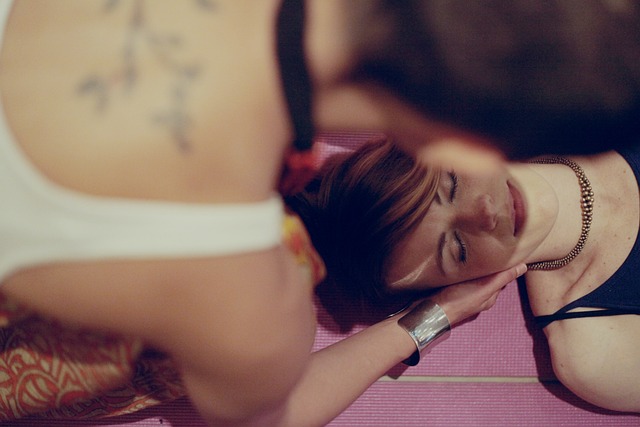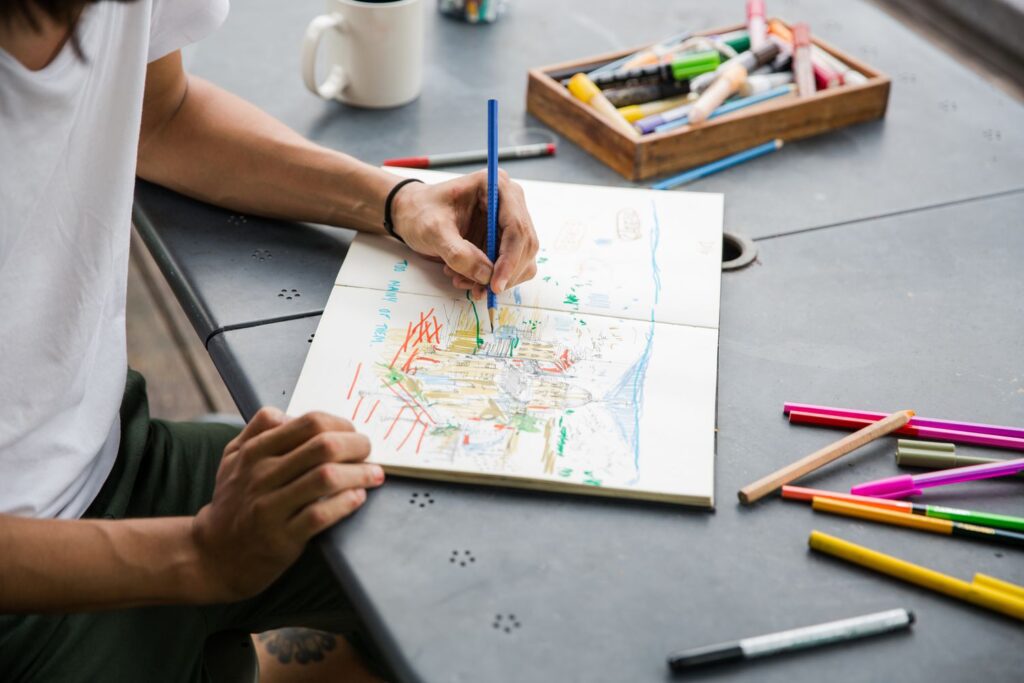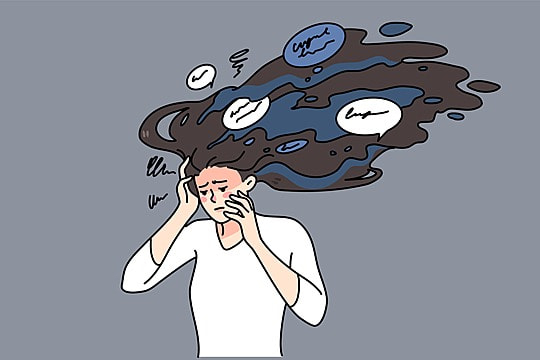Table of Contents

Introduction
Stress, the silent pandemic of our modern era, has become an omnipresent specter that casts its shadow over our mental and physical well-being. It is a multifaceted issue that has permeated every corner of our fast-paced lives, leading to a plethora of health complications ranging from anxiety and depression to high blood pressure and compromised immunity.
In this quest for respite from the relentless tide of stress, people are increasingly turning towards alternative modalities that transcend the realms of traditional stress management, such as art therapy. This blog is an exploratory journey into the profound and burgeoning field of art therapy, delving into its essence, its empirical underpinnings, and presenting a bouquet of ten artistic endeavors that can be effortlessly incorporated into one’s daily routine to combat stress and bolster mental health.
The Enigma of Art Therapy
Art therapy is an innovative form of psychotherapy that employs the power of creative expression to navigate the labyrinth of human emotions and psychological challenges. Conceived in the mid-20th century, this healing art has metamorphosed into a widely acknowledged practice that has found its niche in mental health facilities, educational institutions, hospitals, and rehabilitation centers across the globe. This therapeutic approach leverages the transformative power of art to provide an avenue for emotional exploration and healing.
Key Pillars of Art Therapy:
Nonverbal Communication: Art therapy provides a sanctuary for individuals to articulate their inner turmoils and emotional landscapes without the constraints of language. It is an expressive outlet that transcends the limitations of spoken or written words.
Guiding Hand of Experts: While engaging in creative activities can be inherently therapeutic, the efficacy of art therapy is often amplified under the guidance of a trained art therapist who acts as a facilitator and guide throughout the process.
The Process Over the Product: Unlike traditional art, the therapeutic efficacy of art therapy is not contingent upon the aesthetic appeal of the finished product. Instead, the healing occurs within the act of creation itself, fostering a sense of liberation and catharsis.
Art therapy is a versatile tool that finds its applications in a multitude of scenarios, including the treatment of anxiety, depression, post-traumatic stress disorder, and even the management of chronic illnesses. Its efficacy in stress relief is particularly notable as it engages the mind in a serene and introspective activity.
The Scientific Tapestry of Art Therapy for Stress Relief
While art therapy may be perceived as a purely creative endeavor, it is deeply rooted in the empirical worlds of neuroscience and psychology. Herein lies the magic of how it functions:
Neurochemical Influence: Engaging in artistic endeavors has been scientifically proven to lower cortisol levels, the hormone that is the harbinger of stress. This biochemical shift is instrumental in reducing anxiety and tension.
Activating the Parasympathetic Nervous System: Art therapy induces a state of relaxation by engaging the parasympathetic nervous system, which acts as a counterbalance to the sympathetic nervous system’s fight-or-flight response.
The Dopamine Driven Reward System: The act of creating art is a dopamine-inducing activity that can elevate mood and instill a sense of achievement and pride.
Empirical Evidence: Research has consistently corroborated the stress-reducing properties of art therapy. A study published in the esteemed journal Art Therapy in 2016 demonstrated that participation in creative activities for as little as 45 minutes can lead to significant reductions in stress levels.


The Multifaceted Benefits of Art Therapy for Stress Management
Art therapy offers a holistic approach to tackling stress, encompassing emotional, physical, and social dimensions of well-being.
Emotional Benefits:
Mastery of Emotional Regulation: Art therapy provides a secure environment for individuals to express and process their emotions, thereby fostering emotional intelligence.
Enhanced Self-Awareness: Engaging in creative pursuits encourages introspection, allowing individuals to confront and understand the underlying causes of their stress.
Elevated Mood: The act of creating can act as a mood enhancer, offering a much-needed boost during challenging times.
Physical Benefits:
Modulation of Blood Pressure: Activities such as coloring or painting have been shown to lower blood pressure, a key physiological marker of stress.
Improved Sleep Quality: Art therapy can serve as a precursor to restful slumber, as the relaxation induced by these activities can create a conducive environment for sound sleep.
Social Benefits:
Cultivating Connections: Group art therapy sessions create opportunities for social bonding and support.
Fostering Empathy: Collaborative art projects can enhance interpersonal understanding and empathy among participants.
A Decadal Odyssey of Creative Stress Relief Activities
Embark on a journey of artistic self-discovery with these ten activities that harness the power of art therapy to alleviate stress:
Activity 1: The Mindful Mandala
Mandala coloring, an ancient practice involving intricate geometric designs, is a deeply therapeutic exercise. The rhythmic and meditative act of coloring within these symmetrical patterns can induce a state of tranquility and mindfulness.
The Essence: Mandala coloring engages both hemispheres of the brain, fostering a profound sense of calm and focus.
To Begin: Source printable mandalas or invest in a dedicated coloring book. Use colored pencils or markers to bring the patterns to life.
Expert Advice: Allow yourself to become fully absorbed in the process rather than striving for perfection in the outcome.
Activity 2: The Artful Chronicle
Journaling with an artistic flair involves integrating visual elements into written entries to enrich emotional expression. This practice can be a cathartic experience that enhances emotional clarity.
The Power: Art journaling allows individuals to externalize their thoughts and gain valuable insights into their emotional lives.
Materials: A journal and a smorgasbord of art supplies such as paints, pens, and glue.
Tip: Employ prompts such as “Visualize your current emotional state” or “Create a visual representation of your ideal sanctuary.”
Activity 3: The Emotional Palette
Abstract painting provides a canvas for emotions, offering a nonverbal means of articulating inner turmoil and complex feelings.
Its Effectiveness: The act of applying paint to canvas with intent can serve as a conduit for the expression of emotions.
Necessary Supplies: Acrylic or watercolor paints, brushes, and a canvas or paper substrate.
Suggestion: Choose colors that resonate with your mood and let your feelings guide your brushstrokes.
Activity 4: The Tactile Transformation
Clay modeling or sculpting is a grounding activity that can reduce stress and enhance focus.
Benefits: The physical act of molding clay can serve as a tension reliever and promote mindfulness.
How to Begin: Opt for air-dry clay and create simple forms such as bowls or abstract figures.
Tip: Concentrate on the tactile experience rather than the perfection of the finished piece.
Activity 5: The Collage of Emotions
Collage-making with magazine clippings encourages relaxation and creativity.
How It Helps: The act of selecting and arranging images can be a soothing and contemplative exercise.
The Process: Gather a collection of magazines, scissors, and glue. Curate a visual narrative that resonates with your emotional state or aspirations.
Idea: Construct a mood board that encapsulates your emotions or objectives.
Activity 6: The Natural Canvas
Nature art combines the therapeutic aspects of art with the healing power of the natural world.
Effectiveness: Engaging with nature has been shown to lower stress and improve mood.
Examples: Create leaf prints, floral arrangements, or sculptures using natural materials.
Activity 7: The Meditative Maze
Zentangle is a contemplative drawing method that involves creating repetitive patterns.
Why It Works: The structured nature of Zentangle induces a meditative state.
How to Start: Use a pen and paper to draw simple forms like dots, lines, or spirals.
Guideline: Embrace the notion that there are no mistakes; every line is an integral part of the pattern.
Activity 8: The Visionary Tableau
Vision boards serve as a visual representation of one’s aspirations and can be a powerful tool for stress reduction.
Advantages: Focusing on positive intentions can mitigate anxiety and instill a sense of purpose.
Materials: A poster board, magazines, scissors, glue, and markers.
Idea: Incorporate images and words that encapsulate your dreams and intentions.
Activity 9: The Collective Brushstroke
Collaborative art projects foster a sense of community and reduce feelings of isolation.
Examples: Group murals, collective collages, or communal art installations.
Tip: Emphasize the process of teamwork and shared experience over the final result.
Activity 10: The Melodious Masterpiece
Combining art with music can create a symphony of relaxation and creative expression.
How It Helps: Music can enhance the art-making experience and induce a tranquil state.
The Activity: Listen to soothing music while engaging in an art project, allowing the sounds to influence your artistic expression.
Recommendation: Choose instrumental or nature-inspired tracks to create a serene ambiance.


Embarking on Your Art Therapy Voyage
To effectively harness the stress-reducing properties of art therapy, consider these guidelines:
Silence the Inner Critic: It is essential to approach art therapy with an open mind, free from the constraints of self-doubt.
Create a Sanctuary: Establish a dedicated, clutter-free space that is conducive to creative endeavors.
Consistency is Key: Integrate art therapy into your daily routine to maximize its benefits.
Seek Professional Wisdom: For those grappling with severe stress or trauma, the guidance of a certified art therapist can be invaluable.
The Tapestry of Triumphs: Case Studies and Success Stories
This section will weave together a collection of narratives from individuals who have experienced profound relief and healing through art therapy. We will also delve into the transformative power of art therapy within group settings, highlighting the communal support and shared understanding that can arise from these experiences.
The Multifarious Applications of Art Therapy
We will explore the diverse landscapes of art therapy, including individual versus group sessions, its integration into educational and professional environments, and the burgeoning world of digital art therapy tools.
Individual vs. Group Settings:
Individual art therapy offers a private space for personal exploration and healing.
Group art therapy fosters a sense of belonging and shared experience.
Integration into Schools and Workplaces:
Art therapy can be a valuable asset in educational settings, promoting emotional intelligence and stress relief among students and teachers.
Incorporating art therapy into workplace wellness programs can enhance employee mental health and productivity.
Digital Art Therapy:
The advent of technology has given rise to a plethora of digital tools and apps that facilitate art therapy.
The Treasure Trove of Art Therapy Resources
To aid in your art therapy journey, we have compiled an array of resources, including:
Literature: Recommended books that delve into the theory and practice of art therapy.
Online Courses: Virtual platforms that offer structured learning and professional development opportunities.
Art Supplies: Tips and tricks for sourcing affordable, high-quality art materials.
Professional Organizations: Connect with like-minded individuals and access certifications to advance your art therapy knowledge.


The Conclusion: A Colorful Path to Well-being
Art therapy is a transformative practice that merges the boundless realms of creativity and mindfulness to combat stress and bolster emotional resilience. Whether you choose to color mandalas, sculpt with clay, or compose a vision board, these activities serve as stepping stones towards a more tranquil and balanced existence. Embrace your inner artist and embark on the healing journey that lies within the strokes of a brush, the whispers of a pencil, and the gentle embrace of a canvas.
The art therapy odyssey is an ever-evolving tapestry of creativity, self-discovery, and healing. Through the exploration of this blog, readers will be equipped with a comprehensive understanding of the practice and inspired to incorporate its stress-relieving activities into their lives. With each stroke, color, and form, one can unravel the complexities of the human psyche and weave a more vibrant tapestry of well-being
Art Therapy for Stress Art Therapy for Stress Art Therapy for Stress Art Therapy for Stress Art Therapy for Stress Art Therapy for Stress Art Therapy for Stress Art Therapy for Stress Art Therapy for Stress Art Therapy for Stress Art Therapy for Stress Art Therapy for Stress Art Therapy for Stress Art Therapy for Stress Art Therapy for Stress Art Therapy for Stress Art Therapy for Stress Art Therapy for Stress